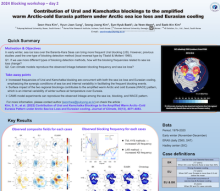Contribution of Ural and Kamchatka Blockings to the Amplified Warm Arctic–Cold Eurasia Pattern under Arctic Sea Ice Loss and Eurasian Cooling
Seon-Hwa
Kim
Pukyong National University, Busan, South Korea
Poster
Previous studies have shown that sea ice loss over the Barents–Kara Seas (BKS) in early winter intensifies surface warming and favors more frequent Ural blocking (UB). Using three different blocking detection methods based on reanalysis and model simulation, we find that the increased occurrences of UB and Kamchatka blocking (KB) over Eurasia are concurrent with both the sea ice loss over the BKS and Eurasian cooling, emphasizing the synergic conditions of sea ice and atmospheric internal variability in facilitating the frequent blocking events. Under the sea ice loss and Eurasian cooling conditions, the KB manifests the strongest surface cold anomaly over northern Eurasia. In contrast, the UB shows either a robust or slightly stronger cold anomaly over Eurasia depending on the conditions above. Consequently, the surface impacts of two regional blockings given the combined conditions of BKS sea ice loss and Eurasian cooling contribute the most to the amplified dipole pattern of Eurasian surface air temperature (SAT). The enhanced dipole pattern shows distinct similarities to the warm Arctic and cold Eurasia (WACE) pattern, previously defined as the second principal mode of winter SAT variability over Eurasia. This implies the role of sea ice loss in reinforcing the internal variability of Eurasian SAT via multiple blocking activities, triggering cold extremes toward Eurasia. Climate simulations with Community Atmosphere Model version 5 (CAM5) can reproduce the observed linkage among sea ice, blocking, and the WACE pattern.

Poster file
Meeting homepage
